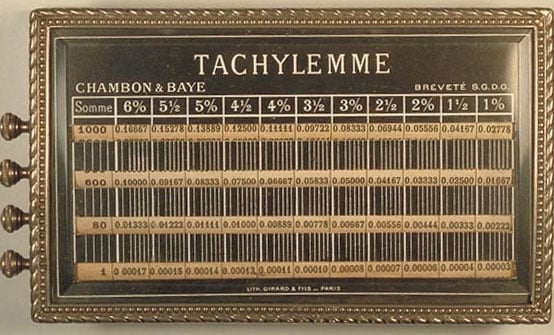3 Facts about Tachylemme of Chambon
- The Tachylemme was a specialized calculator, that showed the daily interest on sums of money at various rates.
- The device was made of wood, paper, metal, and glass, with measurements of 175 x 100 x 35 mm, and weighed 410 g.
- Tachylemme of Chambon could not do operations in huge numbers. However, the ready reckoner tool was much more accurate than most calculating devices at the time.
Tachylemme of Chambon History
The Tachylemme calculator of the Parisian Casimir-Louis Chambon was patented in 1876 (French patent 115319 for Calculateur mécanique universel) and in 1889 (French patent 198553 for Multiplicateur Diviseur) and was produced and sold in 1880s by his company — Chambon et Baye. Chambon was also a holder of several German patents for calculating devices.
The Tachylemme is a specialized calculator, that shows the daily interest on sums of money at various rates.
Quick Facts
- Created
- 1876
- Creator
- Casimir Louis Chambon
- Original Use
- Interest rate calculator
The device was made of wood, paper, metal, and glass, with measurements of 175 x 100 x 35 mm, weighing 410 g. It has four printed cylinders: 1-9; 10-90; 100-900; and 1000-9000, so arranged numbers from one to six percent can be read through slits. For example, a total of 6,216 at 4 percent could be figured by adding the sums shown in the four rows.
Tachylemme of Chambon could not do operations in huge numbers. However, The ready reckoner tool was much more accurate than most calculating devices at the time. Casimir Louis Chambon ensured his calculator produced error-free results to safeguard money exchanges.

Techylemme of Chambon seemed to be an ideal calculator. This is evident from Maurice d’Ocagne words, He said:
This arrangement of the numerical table on adjacent cylinders has the further advantage of being extendable to certain tables having three entries. It is clear that if by some means the numbers read from the cylinders can be made to vary according to the values of a third entry, then a triple barème has been achieved. It is this idea that Mr. Chambon most ingeniously put into practice in his Calculateur d’intérêts, which gives the interest payable, for any number of days, on capital sums up to 99,999 Fr. at rates of 3, 3.5, 4, 4.5, 5, 5.5, and 6%. The vertical columns of the table correspond to the first entry, the number of days. As in the Didelin device, the units, tens, . . . , tens of thousands are assigned to the various cylinders, on each of which an endless loop contains the nine lines corresponding to the second entry.
Although Chambon’s arrangement is most ingenious and most appropriate to the particular application for which it was developed, it does not allow any significant increase in the number of distinct values for the third entry; consequently, its use is rather limited.
Chambon also introduced similar calculators for the multiplication tables, called Multiplicateur Enfantin, an automatic calculator (showing multiplication tables up to 50 times 28), and Tachypoly Plasiasme (showing multiplication tables up to 100 times 100), which were produced in the 1880s in France.
Tachylemme of Chambon: How It Worked
Maurice d’Ocagne words gave a foundation for using the ready reckoner device. Therefore, In order to insert a value in the numerical table, you can shift the crank at the end of the cylinder, and the numbers will be indicated on the cylinder glass. For instance, you can check interest gained at the rate of 3% by turning the number on the cylinder to reflect the amount you want to calculate. After you are done, get to the 3% mark and check the amount reflected. The result will be the total interest gained at a 3% rate.
Tachylemme of Chambon: Historical Significance
Casimir Louis Chambon developed a ready reckoner that was reliable in providing quick answers on money operations. Before the release of Techylemme of Chambon, calculations on interest rates were challenging and, in some cases, could take days before results were found.
Techylemme of Chambon brought a significant change by providing a quick way to calculate interest rates and reckoning these rates within any number of days possible.
